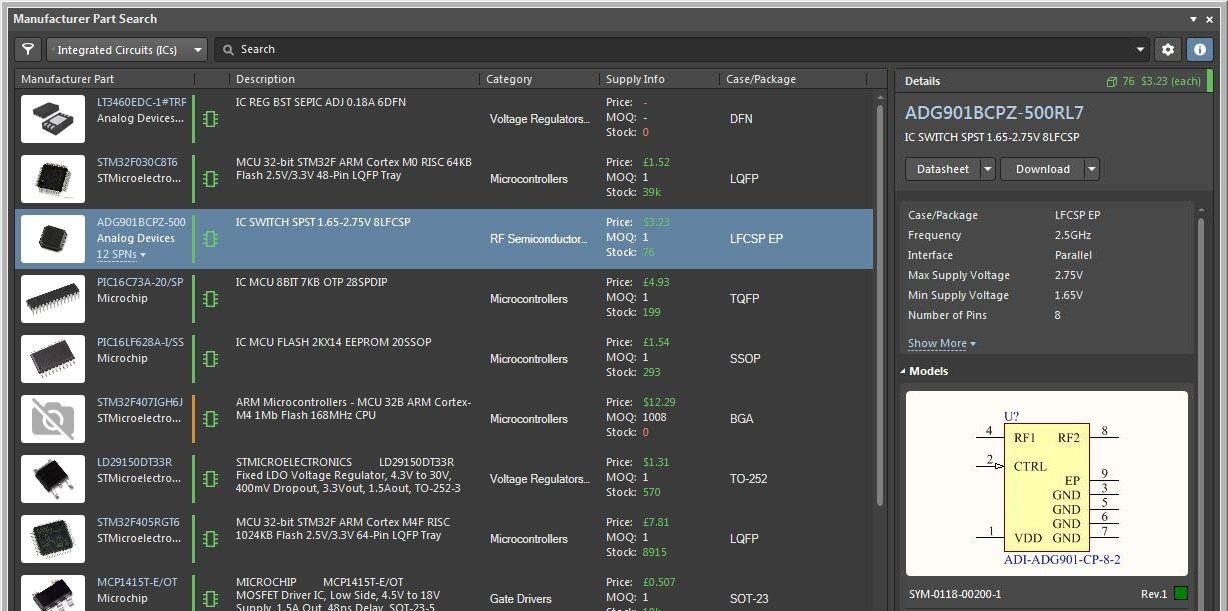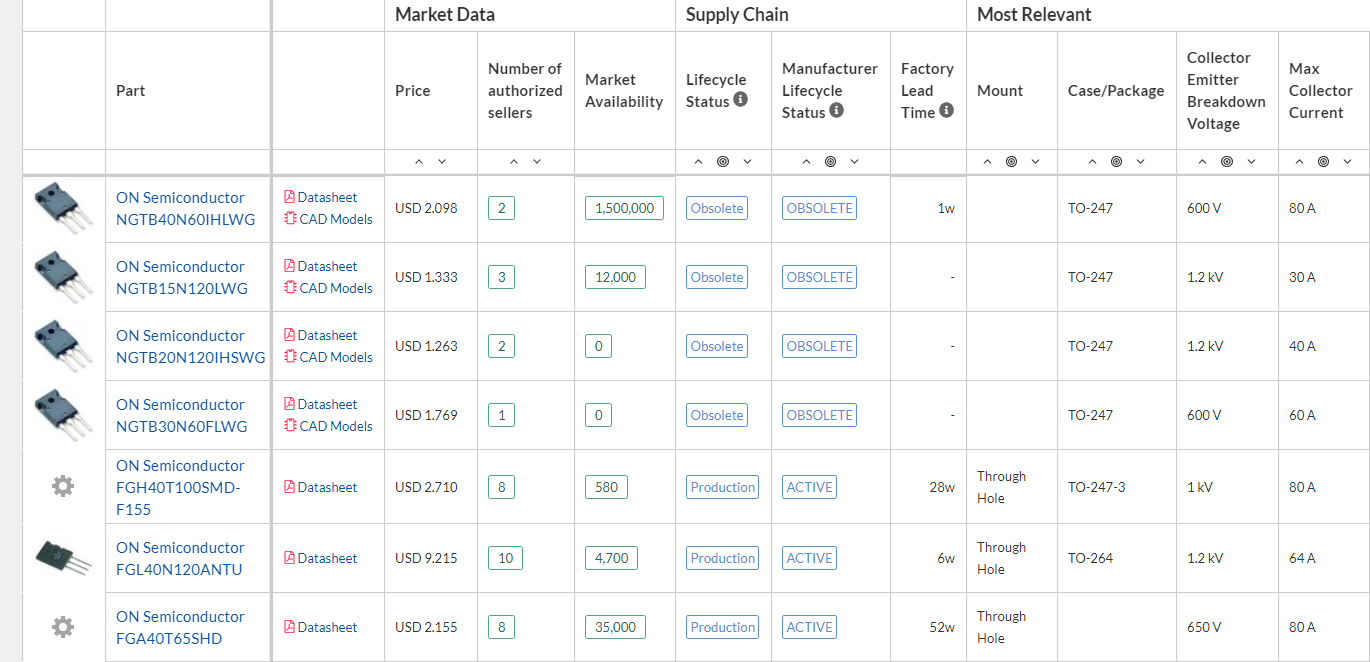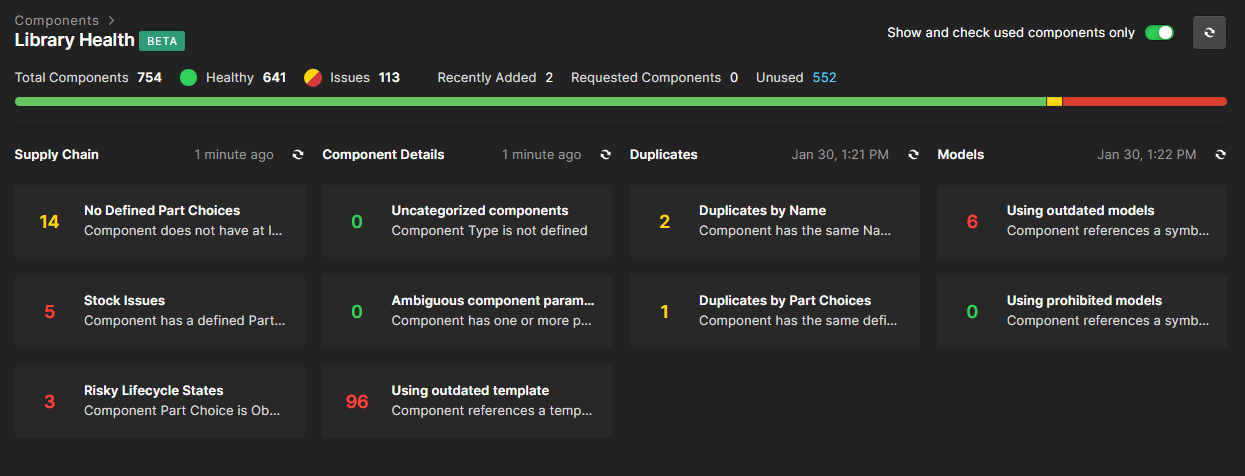How to Automate Electronic Component Data Tracking
When we think of electronic components, it’s natural to think about their specifications, and possibly their footprints and STEP files. There is much more data attached to a component than its specs and CAD data, and it all needs to be tracked to ensure designs can be created, sourced, and manufactured without defects. Instead of using a 3rd party service or pulling data from component manufacturer websites, Altium Designer users have a more powerful option to make sure their component data is always up to date.
Tracking Electronic Component Data
Most designers are probably familiar with the basic anatomy of a PCB library: the main components are the MPN, PCB footprint, schematic symbol, and possibly a simulation file. For some components, none of these data is at risk of changing, but there is other data that could change at any time:
Prices: The electronics supply chain is dynamic, and prices can change at any time. Pricing is based on demand and order size, and small price changes can add up to big differences in pricing.
- Available inventory and lead times: Just like prices can change quickly, so can inventory and lead times. No one wants to use a component in a new design, only to find out that it has a 26 manufacturing week lead time.
- Footprints and STEP models: PCB footprints and STEP models used in a PCB layout may be at risk of changing for various reasons. It may be that the CAD models had some errors that needed to be corrected by the manufacturer, and these need to be updated in your PCB layout.
- Lifecycle: Some components will go obsolete within a few years of being produced and may need to be replaced with newer versions.
If you can compile this information about your components early and ensure it updates periodically, you’re at less risk of a redesign and you’ll always have the latest supply chain information for your components. Altium Designer users are probably familiar with a few features that can be used to keep components up to date.
Manufacturer Part Search Panel
When you’re working in Altium Designer, you can find updates to components by searching your part numbers in the Manufacturer Part Search Panel. This is a nice way to compare variants, view stocks, and quickly get prices, but you can’t automatically check other parts data like CAD models or whether you’ve placed duplicates in your libraries. However, once you’ve located any parts that need to be replaced in your libraries and your PCB layout, the Manufacturer Part Search Panel is a quick way to find and replace components with the newest parts.

ActiveBOM
Once you’re preparing for production, you can use ActiveBOM to get a quick overview of any sourcing problems with your components. This is great for sourcing while preparing an older design for a production run, but it’s not ideal as you can’t automatically check whether CAD data has been updated. Some designers might use ActiveBOM at the end of the design phase, when they start preparing for fabrication and assembly. Still, using ActiveBOM early lets you identify out-of-stock and obsolete/EOL components before you start creating your PCB layout, and it all happens automatically.
Octopart
Although normally used for shopping for new parts, Octopart is a great resource for component information in all the areas listed above. Of particular importance is lifecycle, prices, and stocks, which can all be found in Octopart’s search results.

If you’re a developer, you can build a lightweight web application that integrates with the Octopart API and updates your internal parts database. This is simple enough to do with a Python script and Django; you can create a basic webpage that tracks your parts and updates an internal data with Octopart’s data. This can then be synced back to your Altium 365 Workspace, which will keep all the parts in your Components area updated with fresh information. Once you checkout a project into Altium Designer, your parts data in your projects will be updated with the newest information.
What About Altium 365?
Altium 365, ActiveBOM, and the Manufacturer Part Search Panel in Altium Designer already pull their data from Octopart. However, they all display the data in different ways, and it’s difficult for multiple team members to see all that data in one place. Altium 365 now includes a new feature that shows important checks on sourcing, technical, and CAD data in a single window.
The Component Health Report
Altium 365 brings a new level of automation to electronic component data tracking with the Component Health Report. Every Altium Designer user can access this window from their Altium 365 Workspace through their web browser, there’s no additional application to download. The image below shows an example component health report in an Altium 365 Workspace.

There are some important points to remember when running a component health report:
- Only managed content: The component health report will only run on components that have been migrated to your workspace or are present in projects hosted in your workspace. Components that are in libraries on your local machine can’t be scanned unless they are migrated into Altium 365.
- Used vs. unused components: A component health report can be limited only to components that have been used in your managed PCB projects.
- Data sources: Different data sources can be used to run component health reports, depending on your Altium 365 subscription level. Standard licenses receive content through Octopart, while Pro users can receive content from IHS Markit or an internal database.
Once you’ve run a component health report, you can look through each of these areas to see which components need to be triaged and fixed. From the window shown above, we can see that some components don’t have any sourcing information attached (No Defined Part Choices), are low on inventory (Stock Issues), or are at risk of going obsolete (Risky Lifecycle Status).. There are also duplicates in the libraries, and there are some components that are not using the most recent Component Template.
Resolving Component Problems
Once the problems above have been identified, simply click into each area for instructions on how to resolve component issues. With this new feature available to Altium Designer users, designers don’t need to manually update their electronic component data when creating new designs. It’s best to regularly check the Component Health Report area in your web browser, as well as before you start creating a new design. It’s possible a frequently used component nears the end of its lifecycle or goes out of stock, and designers need this visibility as early as possible.
Don’t use a 3rd party application or service, use the Altium 365™ platform when you want to design, share, and manage your PCB design projects. The electronic component data management features in Altium 365 integrate with the design tools in Altium Designer®, giving you an option to easily create and share your designs in a secure environment.
We have only scratched the surface of what is possible to do with Altium Designer on Altium 365. You can check the product page for a more in-depth feature description or one of the On-Demand Webinars.
